Published TCIMAIL newest issue No.199
Maximum quantity allowed is 999

Protein Electrophoresis
Electrophoresis is a technique which separates charged biomolecules based on the rate at which they migrate in an applied electrical field. In many cases, electrophoresis of proteins are performed using polyacrylamide gel electrophoresis (PAGE).1) For molecular weight estimation and purity determination of proteins, sodium dodecyl sulfate (SDS)-PAGE is frequently employed. SDS is a strong denaturant of proteins and is added to samples, gels, and buffer solutions for electrodes when proteins are separated with electrophoresis. As SDS not only denatures protein but also binds to the protein, when SDS is used in conjunction with a reducing reagent such as 2-mercaptoethanol to cleave disulfide bonds in the protein, and the protein is completely denatured, the amount of SDS bound is almost always proportional to the molecular weight of the protein. Resultantly, the protein is negatively charged. Therefore, the denatured protein can be separated by molecular weight independently of its structure and biological properties.
Laemmli’s method is the most widely used system of SDS-PAGE.2) In this method, the separation and the stacking gel contain Tris-HCl and the upper and lower buffer reservoirs contain Tris-glycine. All components of the system contain SDS. The advantage of Laemmli’s method is that it gives sharper bands in the final plate.1)
Reagents for Gel Preparation, Buffer Preparation, etc.
- A3217
- 30% Acrylamide / Bis-acrylamide (29:1) [for Electrophoresis]
- A3218
- 30% Acrylamide / Bis-acrylamide (37.5:1) [for Electrophoresis]
- A1132
- Acrylamide Monomer [for Electrophoresis]
- M0506
- N,N'-Methylenebisacrylamide [for Electrophoresis]
- A2098
- Ammonium Peroxodisulfate [for Electrophoresis]
- B3195
- Bromophenol Blue Sodium Salt (= BPB) [for Electrophoresis]
- D3647
- DL-Dithiothreitol (= DL-DTT) [for Electrophoresis]
- G0316
- Glycerol [for Electrophoresis]
- G0317
- Glycine [for Electrophoresis]
- M1948
- 2-Mercaptoethanol [for Electrophoresis]
- S0588
- Sodium Dodecyl Sulfate (= SDS) [for Electrophoresis]
- T2515
- N,N,N',N'-Tetramethylethylenediamine (= TEMED) [for Electrophoresis]
- T2516
- Tris(hydroxymethyl)aminomethane (= Tris-Base) [for Electrophoresis]
- T3843
- 1-Thioglycerol [for Electrophoresis]
SDS-PAGE Sample Buffers
Sample buffers are available in three different concentrations to allow for easy use with any sample volume. No reducing agent is included-add as required. A red sample bufferis also available to help prevent sample mix-up.
- B5834
- 2X SDS-PAGE Sample Buffer (2-Mercaptoethanol free) [for Electrophoresis]
- B6104
- 4X SDS-PAGE Sample Buffer (2-Mercaptoethanol free) [for Electrophoresis]
- B6105
- 6X Sample Buffer (2-Mercaptoethanol free) [for Electrophoresis]
- B6110
- 2X SDS-PAGE Sample Buffer Phenol Red (2-Mercaptoethanol free) [for Electrophoresis]
Example of use (SDS-PAGE Sample Buffers)
Electrophoresis samples were prepared and applied to acrylamide gels using each of the following sample buffers.
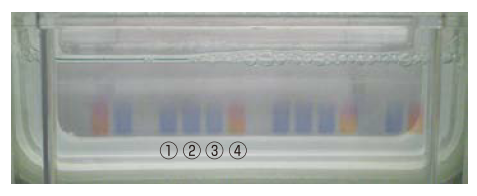
Figure. View during gel application using four sample buffers
① 2X SDS-PAGE Sample Buffer (Product No. B5834)
② 4X SDS-PAGE Sample Buffer (Product No. B6104)
③ 6X Sample Buffer (Product No. B6105)
④ 2X SDS-PAGE Sample Buffer Phenol Red (Product No. B6110)
Gel Staining Reagent 1 (Silver Staining Kit for Safe and Sensitive Protein Detection)
Detecting protein bands in a polyacrylamide gel after electrophoresis requires the gel to be stained. Common staining methods include Coomassie Brilliant Blue staining, silver staining, fluorescence staining, and negative staining.
Silver staining is a commonly-used method for the detection of proteins and DNA in polyacrylamide gels after electrophoresis.3) In this method, silver ions are bound to proteins and DNA present in the gel and reduced, resulting in stained bands. Silver staining is more sensitive than Coomassie Brilliant Blue (CBB) staining; it can detect down to nanogram amounts of protein.
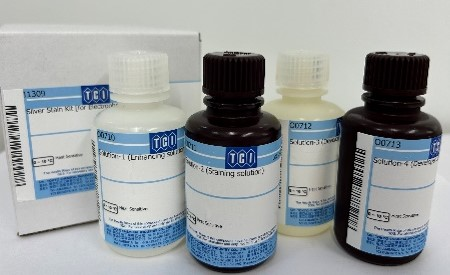
Figure. Product Appearance of I1309
Example of use (Staining gels with I1309)
- Prepare Fixing Solution, Staining Solution, Developer Solution, and Stop Solution by diluting the supplied solutions 100-fold.
- In a clean tray, submerge the gel in Fixing Solution, and allow to incubate with shaking for 10 minutes.
- Remove Fixing Solution, and wash gel in deionized water with shaking for 10 minutes. (Repeat a total of three times.)
- Remove deionized water and replace with Staining Solution. Incubate with shaking for 5 minutes.
- Remove Staining Solution and replace with deionized water. Incubate with shaking for 30 seconds.
- Remove deionized water and replace with Developer Solution. Incubate with shaking for 30 seconds.
- Replace old Developer Solution with fresh solution. Incubate with shaking until developed bands appear.
- Replace old Developer Solution with fresh solution. Incubate with shaking until developed bands appear.
- Remove Stop Solution, and wash gel a total of three times with deionized water, incubating with shaking for 5 minutes each wash.
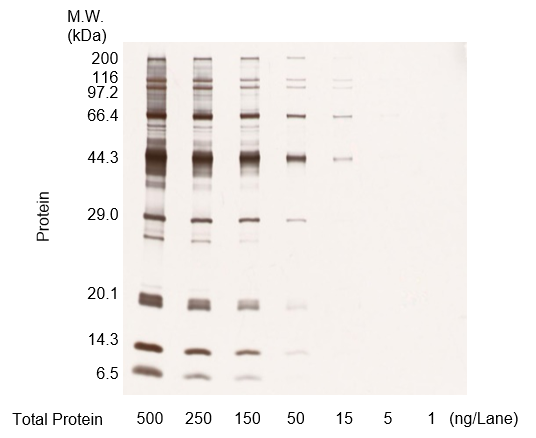
Figure A. Protein molecular weight markers were diluted, run on an acrylamide gel, and stained
(500 ng/lane, 250 ng/lane, 150 ng/lane, 50 ng/lane, 15 ng/lane, 5 ng/lane, 1 ng/lane)
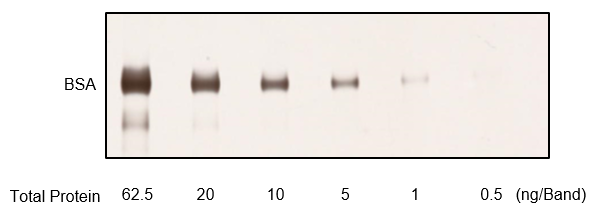
Figure B. BSA was diluted, run on an acrylamide gel, and stained
(62.5 ng/band, 20 ng/band, 10 ng/band, 5 ng/band, 1 ng/band, 0.5 ng/band)
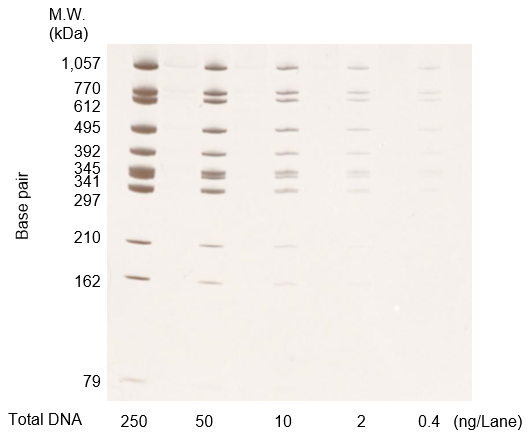
Figure C. DNA molecular weight markers at each concentration were diluted, run on an acrylamide gel, and stained
(250 ng/lane, 50 ng/lane, 10 ng/lane, 2 ng/lane, 0.4 ng/lane)
Gel Staining Reagent 2 (Gel Negative-Staining Kit for Rapid and Highly Sensitive Protein Detection)
Negative staining is a method in which only regions of gel containing protein remain unstained, while the remainder of the gel is stained white.4) Bands can be visualized by placing the gel against a dark background.
Gel Negative Stain kit can be used to detect protein bands with high sensitivity in as little as 20 minutes. Furthermore, stained gels can easily be destained using the included destaining solution, with the destained gel is able to be used in further downstream applications, such as Western blotting and mass spectrometry.5,6)
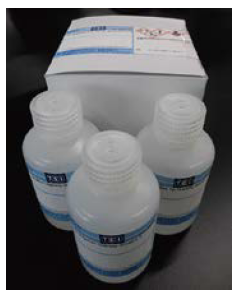
Figure. Product Appearance of G0615
Example of use (Staining gels with G0615)
- Place the post-SDS-PAGE gel in a tray containing enough deionized water to cover the gel and shake for 10 minutes.
- Discard the deionized water, add enough solution A (diluted 10 times with deionized water) to cover the gel and shake for 5 minutes.
- Submerge gel in deionized water for 10 seconds to wash. Repeat three times.
- Transfer the gel to a new tray, add enough solution B (diluted 10 times with deionized water) to cover the gel and shake for 1 minute to develop color.
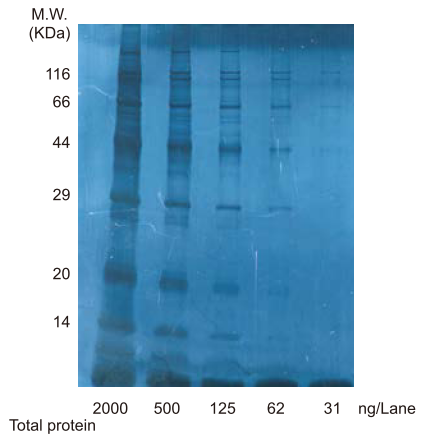
Figure. Photograph of gel stained by G0615
Example of use (Preparation of gel for Western Blotting)
- Place the stained and photographed gel in a tray containing solution C diluted 10-fold with deionized water.
- Shake the gel until the color is removed.
- Discard solution C, add enough deionized water to cover the gel and wash for 30 seconds. Repeat three times.
- Transfer the washed gel to a membrane (PVDF).
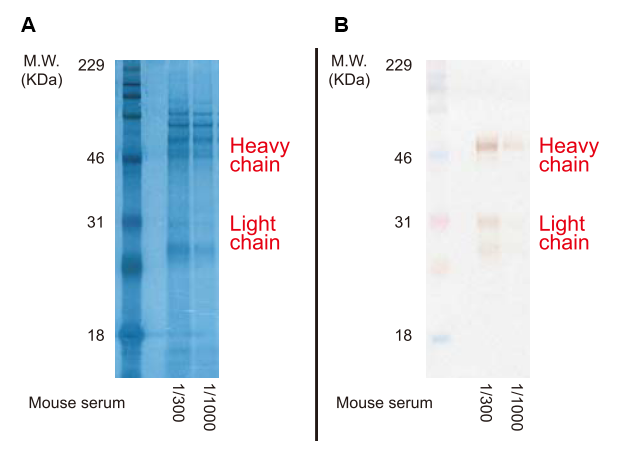
Figure. A: Gels loaded with mouse serum and stained with G0615.
B: The gel in A was destained and mouse IgG was detected via Western Blotting.
Gel Staining Reagent 3 (Methanol-free CBB Stain Solution)
C3488 is a methanol- and acetic acid-free one-component ready-to-use solution for staining proteins. After polyacrylamide gelelectrophoresis, C3488 can be used for protein staining by soaking the gel in C3488.
Example of use (Staining gels with C3488)
- After gelelectrophoresis, wash the gel with deionized water for 5 minutes three times.
- Remove the water, add C3488 till the gel is soaked and shake the gel gently for 1 hour at room temperature.
- Remove C3488 and destain the gel with deionized water for 1 hour. If high background staining is observed, destain the gel with deionized water overnight at room temperature.
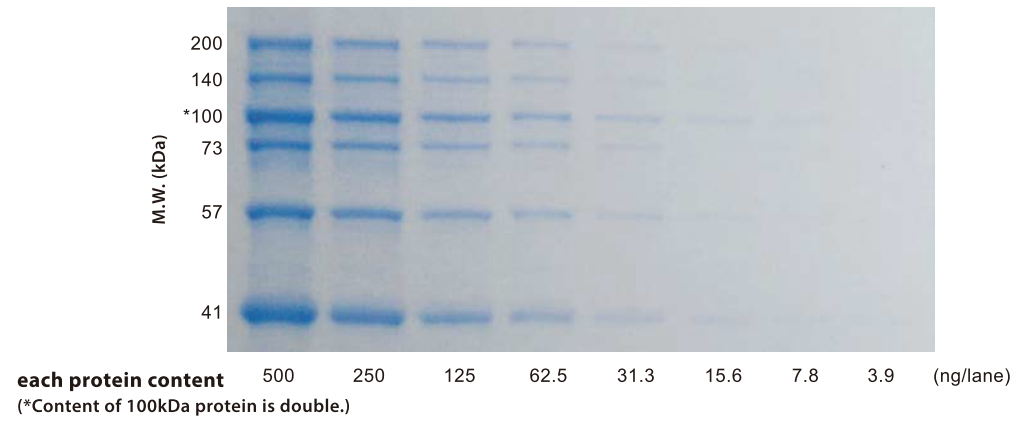
Figure. Proteins stained by C3488 (destained overnight)
Comparison of Silver Staining, Negative Staining and CBB Staining
| Staining Reagent | Time | Detection sensitivity | Advantages |
|---|---|---|---|
| Silver Stain (Product No. I1309) | ~1 hour | Several ng | Highly sensitive detection method with ample track record. Able to detect both protein and DNA. |
| Negative Stain (Product No. G0615) | 15 - 30 minutes | Several ng | Short staining time. Stained gels can be used for Western blotting, etc. |
| CBB Stain (Product No. C3488) | 2 hours - over night | Several µg | Easy-to-use, simple protocol. Resultant bands are quantifiable. |
Reagents for Protein Staining and Others
- A2097
- Acid Black 1 (= Amido Black 10B) [for Electrophoresis]
- A2256
- Acid Red 112 (= Ponceau S) [for Biochemical Research]
- B3193
- Coomassie Brilliant Blue G-250 [for Electrophoresis]
- B3194
- Coomassie Brilliant Blue R-250 [for Electrophoresis]
- F0718
- Fast Green FCF [for Biochemical Research]
- D1820
- Sodium Deoxycholate [for Electrophoresis]
- A2255
- 6-Aminohexanoic Acid [for Biochemical Research]
DNA Electrophoresis
Agarose gel electrophoresis is one of the most common methods used to size-separate and analyze DNA. The nucleotides that make up DNA carry a negative charge due to their phosphate groups, and are therefore attracted to the anode when run on an agarose gel. As the DNA moves through the gaps in the mesh of the agarose gel, longer molecules, with higher molecular weights, move more slowly, while smaller molecules are able to move more quickly. This method, of separating molecules by size on a gel using electricity, is known as gel electrophoresis.6)
Nucleic Acid Staining Reagent (Ethidium Bromide Solution)
Ethidium bromide is widely used as a DNA staining agent with agarose gels and can detect DNA with high sensitivity through visualization using UV light.7) However, its carcinogenicity6) means it must be handled with care. E1363 comes in a dropper bottle pre-dissolved, making it safe and easy to use.
Example of use (Staining gels with E1363)
- After electrophoresis, dilute E1363 (1 drop / 40 mL) to 0.5 µg/mL with water or running buffer and incubate the gel for 15 minutes.
- If you have to decrease background fluorescence, wash the gel in water for 15 minutes.
- In use of electrophoresis buffer solution, Ethidium bromide incorporated into nucleic acid and can visualize band immediately by using UV transilluminator.
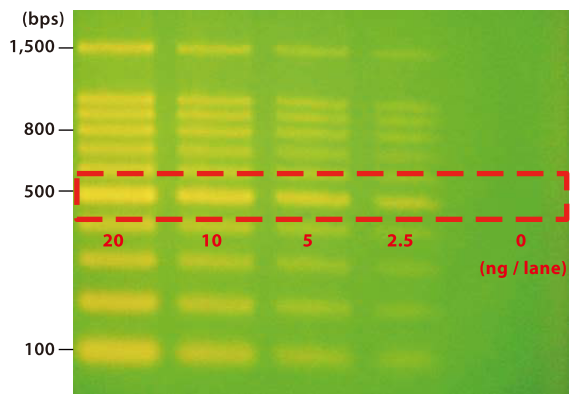
Figure. DNA Ladder Marker stained by E1363 (destained 15 minutes)
Nucleic Acid Staining Reagent (Nucleic Acid Stain Blue)
Nucleic acid stain blue is used to stain nucleic acids after agarose gel electrophoresis. As nucleic acids are stained blue, no transilluminator or other detection device is required. Unlike ethidium bromide, it is non-mutagenic and therefore safe and easy to handle.
Example of use (Staining gels with N1209)
- Prepare N1209 diluted 10 times with deionized water.
- After electrophoresis, immerse the gel in the diluted N1209 and shake for 10 minutes.
- Discard the staining solution and shake the gel with deionized water for 30 minutes and wash the gel. Repeat the wash step if background is high.
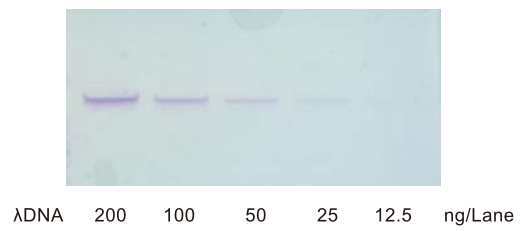
Figure. Photograph of gel stained by N1209 (destained overnight)
References
- 1) J. Sambrook, D. W. Russell, in Molecular Cloning, A Laboratory Manual, 3rd ed., Cold Spring Harbor Laboratory Press, New York, 2001.
- 2) Cleavage of Structural Proteins during the Assembly of the Head of Bacteriophage T4
- 3) DEVELOPMENT AND MECHANISMS OF SILVER STAINS FOR ELECTROPHORESIS
- 4) Detection of Proteins in Polyacrylamide Gels by Silver Staining
- 5) Understanding the mechanism of the zinc-ion stains of biomacromolecules in electrophoresis gels: Generalization of the reverse-staining technique
- 6) A procedure for protein elution from reverse-stained polyacrylamide gels applicable at the low picomole level: An alternative route to the preparation of low abundance proteins for microanalysis
- 7) High Yield Elution of Proteins from Sodium Dodecyl Sulfate–Polyacrylamide Gels at the Low-Picomole Level. Application to N-Terminal Sequencing of a Scarce Protein and to In-Solution Biological Activity Analysis of On-Gel Renatured Proteins
- 8) Agarose Gel Electrophoresis for the Separation of DNA Fragments
- 9) Detection of DNA in Agarose Gels
- J. Sambrook, D. W. Russell, in Molecular Cloning, A Laboratory Manual, 3rd ed., Cold Spring Harbor Laboratory Press, New York, 2001, vol. 1, Chap. 5, 14.

